In the tech world, trends often emerge that capture the imagination, often overshadowing practical applications. Transparent displays are one such innovation that has generated buzz in recent years. Initially, I expressed skepticism about their practical utility, believing they served primarily as a marketing gimmick. However, attending CES 2025 at the Las Vegas Convention Center has led me to reassess my previous dismissal of these captivating screens, albeit with cautious skepticism.
The Enchantment of the Transparent Display
At CES 2025, LG showcased a stunning transparent OLED TV display, illustrating their commitment to pushing visual boundaries. As I stood transfixed, watching a series of 77-inch screens harmoniously rotate while reflecting the ambient light, I found myself caught up in the spectacle. This mesmerizing display, while undeniably impressive, left me pondering the deeper implications of such technology. Is this truly revolutionary, or merely an artistic showcase that distracts from the lack of tangible benefits?
Often, we conflate visual appeal with functional innovation, and transparent screens epitomize this phenomenon. Even as I acknowledge the artistry in creating a transparent display, I struggled to visualize a scenario where it could be practically integrated into everyday life. For an average consumer, the appeal dwindles when confronted with the substantial price tag—around $60,000 for such a display. It compels one to wonder: do these screens exist solely to dazzle at trade shows rather than serve genuine consumer needs?
My fascination with the cyberpunk aesthetic, characterized by neon lights and digital interfaces, complicated my response to the transparent display. It is a potent source of inspiration, one that speaks to the intersection of art and technology. Yet, the allure of such gadgets often leads to a disconnect between desire and necessity. In this instance, I found myself teetering on the brink of impulse, drawn in by the sheer spectacle of the display rather than rational evaluation.
As I admired the LG display, I recalled similar feelings from previous experiences at trade shows, witnessing awe-inducing tech that ultimately lacked practicality. It raises an important question: how long will consumers continue to be enchanted by innovations that prioritize aesthetics over functionality? The transparency, while visually intriguing, raises concerns about usability. How does one utilize a screen that offers such limited practical application without compromising on the essence of traditional displays?
The Competition: A Quest for More Practical Displays
Later in the day, I stumbled upon another impressive display—the 163-inch Micro LED TCL X11H Max. Unlike the transparent screen, this model spoke directly to the gaming community, boasting a response time measured in nanoseconds and an impressive brightness of 10,000 nits, all for the not-so-modest price of $110,000. While this price may dissuade many, the potential for immersive gaming experiences makes it a tantalizing option for enthusiasts willing to splurge.
The stark contrast between the two displays made me reconsider the practical applications of modern screen technology. While the LG transparent display serves primarily as a spectacle, the TCL X11H Max aligns itself squarely with today’s consumer demands—high-quality gaming experiences. In an age where gaming continues to captivate audiences globally, displays that enhance, rather than merely impress, offer a more viable path forward.
Reflecting on my experience at CES 2025 brings me back to the pivotal question of digital displays: Are we chasing beauty at the expense of utility? Transparent displays may dazzle and captivate, but their place in a consumer’s home is tenuous at best. While I can appreciate the artistry and innovation they represent, I find myself favoring technologies that prioritize practical application over transient beauty.
Ultimately, as the industry progresses and new technologies emerge, it is vital to weigh the balance between aesthetic pleasure and functional value. The allure of transparent displays will surely capture attention for years to come, yet grounded realities may guide consumers toward technology that enhances their daily lives, proving that innovation does not always equate to necessity.

